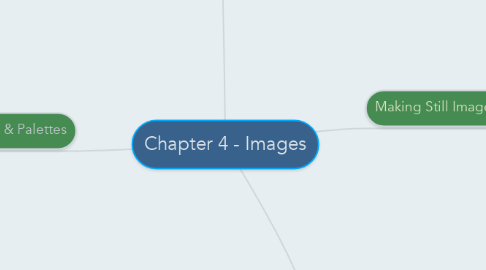
1. 3-D Drawing and Rendering
1.1. Features OF 3-D application
1.1.1. Modeling
1.1.2. Extrusion
1.1.3. Lathing
1.2. Rendering
1.2.1. Use of intricate algorithms to apply user-specified effects
2. Colors & Palettes
2.1. Natural Light & Color
2.1.1. Concept
2.1.2. Addictive Color
2.1.3. Subtrative colors
2.1.4. Color Models
2.1.5. Color Palettes
2.1.5.1. mathematical tables that define the color of pixels displayed on the screen.
2.1.6. Dithering
2.1.6.1. a process whereby the color value of each pixel is changed to the closest matching color value in the target palette.
2.1.6.2. done using a mathematical algorithm.
3. Image File Types
3.1. Macintosh Formats
3.2. Windows Formats
3.3. Cross-Platform Formats
4. Making Still Images
4.1. Bitmaps
4.1.1. Combination of blocks of different pixels with different values
4.1.2. Suited for creation of
4.1.2.1. Photo-realistic Images
4.1.2.2. Complex drawings requiring fine details
4.1.3. Bitmap Sources
4.1.3.1. Slide 11 - 13
4.1.3.2. Legal Rights
4.1.3.2.1. Public Domain Images
4.1.3.2.2. Royalty-free Images
4.1.3.2.3. Right-managed Images
4.2. Capturing & Editing ImageS
4.2.1. Ability of Image editing Programs
4.2.1.1. Enhance and make composite images
4.2.1.2. Alter and distort images
4.2.1.3. Add and delete elements
4.2.1.4. Morph ,allow to smoothly blend two images so that one image seems to melt into the next
4.3. Vector-drawn Graphics
4.3.1. Application
4.3.1.1. Computer-aided design (CAD) programs needed by architects and engineers
4.3.1.2. Graphic artists designing for the print media
4.3.1.3. 3-D animation programs – changes of position, rotation, and shading of light
4.3.1.4. Applications requiring drawing of graphic shapes
4.3.2. How Vector-drawn Images work
4.3.2.1. a line that is described by the location of its two endpoints.
4.3.2.2. makes use of Cartesian coordinates. (numbers that describe a point in two- or three-dimensional space as the intersection of the X, Y, and Z axes.)
4.3.3. Vector-drawn images VS. Bitmap
4.3.3.1. Less Memory space & smaller file size compared tobitmaps
4.3.3.2. pages that use vector graphics in plug-ins download faster & draw animation faster than bitmaps.
4.3.3.3. Vector objects are easily scalable without loss of resolution or image quality
4.3.3.4. Vector image - a rescaled image retains the quality of the original.
4.3.3.5. Vector images cannot be used for photorealistic images
4.3.3.6. Vector images require a plug-in for web-based display.
4.3.3.7. Bitmaps are not easily scalable and resizable.
4.3.3.8. Bitmaps can be converted to vector images using autotracing.
